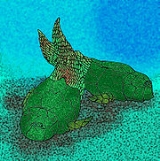
Antiarchi
Encyclopedia
The Antiarchi were the 2nd most successful order of placoderms known, after the Arthrodira
. The order's name was coined by Edward Drinker Cope
, who, when examining some fossils that he thought were armored tunicate
s related to Chelysoma, mistakenly thought that the eye-hole was the mouth, and that the opening for the anal siphon was on the other side of the body, as opposed to having both oral and anal siphons together at one end.
The front portions of their bodies were heavily armored, to the point of literally resembling a box with eyes, with the sometimes scaled, sometimes naked rear portions often becoming sinuous, particularly with later forms. The pair of pectoral fins were modified into a pair of caliper
-like, or arthropod
-like limbs. In primitive forms, such as Yunnanolepis
, the limbs were thick and short, while in advanced forms, such as Bothriolepis
, the limbs were long and had elbow-like joints. The function of the limbs are still not perfectly understood, but, most hypothesize that they helped their owners pull themselves across the substrate, as well as allow their owners to bury themselves into the substrate.
Arthrodira
Arthrodira is an order of extinct armoured jawed fishes of the Placodermi class that flourished in the Devonian period before their sudden extinction, surviving for about 50 million years and penetrating most marine ecological niches....
. The order's name was coined by Edward Drinker Cope
Edward Drinker Cope
Edward Drinker Cope was an American paleontologist and comparative anatomist, as well as a noted herpetologist and ichthyologist. Born to a wealthy Quaker family, Cope distinguished himself as a child prodigy interested in science; he published his first scientific paper at the age of nineteen...
, who, when examining some fossils that he thought were armored tunicate
Tunicate
Tunicates, also known as urochordates, are members of the subphylum Tunicata, previously known as Urochordata, a group of underwater saclike filter feeders with incurrent and excurrent siphons that is classified within the phylum Chordata. While most tunicates live on the ocean floor, others such...
s related to Chelysoma, mistakenly thought that the eye-hole was the mouth, and that the opening for the anal siphon was on the other side of the body, as opposed to having both oral and anal siphons together at one end.
The front portions of their bodies were heavily armored, to the point of literally resembling a box with eyes, with the sometimes scaled, sometimes naked rear portions often becoming sinuous, particularly with later forms. The pair of pectoral fins were modified into a pair of caliper
Caliper
A caliper is a device used to measure the distance between two opposing sides of an object. A caliper can be as simple as a compass with inward or outward-facing points...
-like, or arthropod
Arthropod
An arthropod is an invertebrate animal having an exoskeleton , a segmented body, and jointed appendages. Arthropods are members of the phylum Arthropoda , and include the insects, arachnids, crustaceans, and others...
-like limbs. In primitive forms, such as Yunnanolepis
Yunnanolepis
Yunnanolepis is an extinct genus of primitive Antiarch placoderm. It was first named by Liu in 1963. Its fossils are found in Early Devonian strata in Southern China and Middle Devonian strata in Vietnam.-External links:* at the Paleobiology Database...
, the limbs were thick and short, while in advanced forms, such as Bothriolepis
Bothriolepis
Bothriolepis was the most successful genus of antiarch placoderms, if not the most successful genus of any placoderm, with over 100 species found on every continent.-Description and palaeobiology:...
, the limbs were long and had elbow-like joints. The function of the limbs are still not perfectly understood, but, most hypothesize that they helped their owners pull themselves across the substrate, as well as allow their owners to bury themselves into the substrate.

